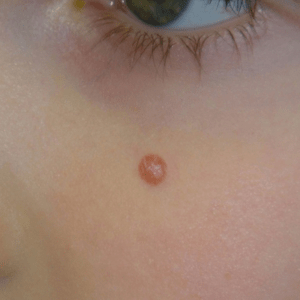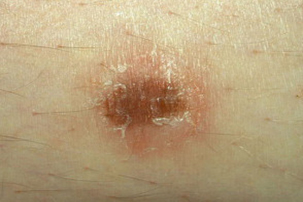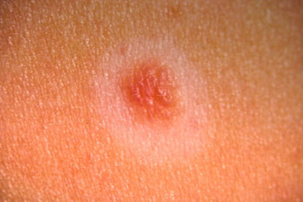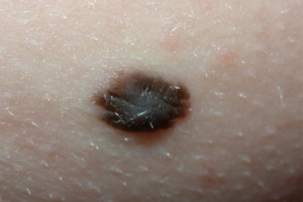
concern
DERMAL NEVUS (MOLE)
(NEE·VUHS)
WHAT IS A NEVUS?
A Dermal Nevus is a harmless collection of colored cells that typically appear as small brown, tan, or pink spots.
An individual can be either born with nevi or develop them later on in life. However, an acquired Nevus is one that developed during a person’s adolescence.
TYPES OF NEVUS:

Congenital Nevus
Dysplastic Nevus
Dysplastic nevus (also known as “atypical mole”) are benign (noncancerous) but often resemble melanoma. These moles can feature different colors and possibly appear asymmetrical. People with dysplastic nevi are at a higher risk of developing melanoma.

Miescher Nevus

Common Nevus

Blue Nevus
A blue nevus is a blue-colored mole that can be congenital (born with it) or acquired (develops later in life). A blue nevus appears flat or dome-shaped with discoloration ranging from blue-grey to blue-black. Blue nevi are commonly found in people of Asian descent.

Spitz Nevus
A Spitz nevus is a raised, pink, dome-shaped mole that typically appears before age 20. Spitz nevi vary in color and can bleed or ooze, they are also difficult to distinguish from melanoma.

Unna Nevus
Unna nevi are soft, brownish moles that resemble Miescher nevi and can look like a raspberry. They are usually located on the abdomen, the arms, or the neck.

Meyerson nevus

Halo Nevus

Reed Nevus

Agminated Nevus
THE ABCDE RULE:
A = Asymmetry: One-half of a mole does not have the same shape as the other half.
B = Border: The edge of a mole is uneven (irregular). It can look jagged, notched, or blurry. The color may spread into the area around the mole.
C = Colour: The color of a mole is not the same throughout. It could have shades of tan, brown, and black. Sometimes areas of blue, grey, red, pink, or white are also seen.
D = Diameter: The size of a mole is larger than 6mm across, which is about the size of a pencil eraser.
E = Evolving: There is a change in the color, size, shape, or feel of the mole. The mole may become itchy or you may have a burning or tingling feeling.